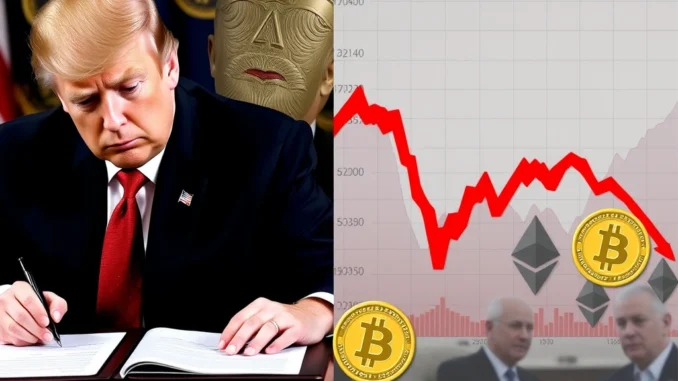
Just when you thought the crypto market might be breaking free, a familiar pattern emerges. Despite high hopes pinned on recent pro-crypto moves by former President Trump, Bitcoin and Ethereum took a nosedive. Let’s dive into why the crypto world is experiencing this unexpected market downturn and what it means for your investments.
Why Are Bitcoin and Ethereum Plunging Despite Positive Crypto News?
On March 11th, Asia woke up to a sea of red in the crypto markets. Bitcoin (BTC) and Ethereum (ETH), the two giants of the crypto world, experienced significant drops. Bitcoin fell by over 3%, while Ethereum took a harder hit, plummeting more than 6%. This sharp decline was mirrored by a downturn in the U.S. stock markets, according to Bloomberg reports. The tech-heavy Nasdaq 100 index fell by a concerning 3.8%, and Ethereum’s price sank to levels not seen since October 2023.
Adding fuel to the fire, even ETFs linked to Strategy, a company holding substantial Bitcoin, witnessed a staggering decrease of over 30% in a single day. This widespread downturn raises a crucial question: Why are these digital assets falling, especially when considering recent seemingly positive developments in the crypto space?
Trump’s Crypto Moves: A Case of Too Little, Too Late?
In a move that many in the crypto community hoped would inject confidence into the market, former U.S. President Donald Trump recently took what appeared to be proactive steps towards cryptocurrency adoption. These actions included:
- Executive Order for Strategic Bitcoin Reserve: An order to establish a national reserve of Bitcoin, signaling a potential long-term commitment to digital assets.
- Stockpile for Other Tokens: Extending the reserve concept to include a variety of other cryptocurrencies, broadening the scope of government crypto holdings.
- White House Crypto Summit: Chairing a summit focused on cryptocurrency, indicating a high-level discussion and focus on the industry’s future.
On paper, these initiatives sound like a significant win for crypto. However, the market’s reaction tells a different story. The stark reality is that these measures, at least in the short term, failed to prevent the current market downturn. This begs the question: Are these actions merely symbolic, or are there deeper market forces at play?
The Intensifying Link Between Crypto Equities and Traditional Markets
Joshua Lim, Co-Head of Markets at FalconX Global, offers a compelling perspective on the situation. He observed that the correlation between Bitcoin’s performance and traditional equity markets is becoming increasingly strong. This means that Bitcoin, once touted as a decentralized and uncorrelated asset, is now behaving more like a tech stock.
This intensified correlation is crucial for investors to understand. It suggests that:
- Crypto is not immune to traditional market pressures: Global economic anxieties and stock market volatility can directly impact crypto prices.
- Portfolio diversification benefits are reduced: If crypto moves in sync with equities, its effectiveness as a hedge against stock market downturns diminishes.
- Macroeconomic factors are increasingly relevant: Crypto investors need to pay closer attention to broader economic trends and events impacting traditional markets.
This growing interconnectedness is a significant shift and challenges the narrative of crypto as a completely independent asset class.
Wall Street Woes and Global Economic Uncertainty
The timing of this crypto dip is no coincidence. It aligns with growing apprehension on Wall Street. President Trump’s warnings about potential economic turbulence stemming from trade disputes with key trading partners like Canada, Mexico, and China have rattled investor confidence.
These trade disputes inject uncertainty into the global economic outlook, leading to:
- Stock market jitters: Concerns about tariffs and trade barriers often trigger stock market declines as companies worry about reduced profits and disrupted supply chains.
- Risk-off sentiment: In times of economic uncertainty, investors tend to move away from riskier assets like stocks and, increasingly, cryptocurrencies, seeking safer havens.
- Dollar strength: Economic uncertainty can sometimes strengthen the U.S. dollar, which can inversely affect the price of assets like Bitcoin that are often priced in USD.
It appears that these macroeconomic anxieties are overshadowing any positive sentiment generated by Trump’s crypto moves, highlighting the powerful influence of global economic factors on the crypto market.
Navigating the Crypto-Equity Link: What Should Investors Do?
The strengthening link between crypto equities and traditional markets presents both challenges and opportunities for investors. Here are some actionable insights:
- Monitor Traditional Markets: Keep a close eye on stock market trends, economic news, and geopolitical events. These factors can provide valuable clues about potential crypto market movements.
- Reassess Portfolio Diversification: If you believed crypto was your uncorrelated hedge, reconsider your portfolio strategy. Explore other asset classes that might offer true diversification.
- Focus on Fundamental Analysis: In a correlated market, the long-term value of crypto projects becomes even more critical. Focus on projects with strong fundamentals, real-world use cases, and solid teams.
- Manage Risk Actively: Be prepared for increased volatility and potential correlation-driven dips. Employ risk management strategies like stop-loss orders and portfolio rebalancing.
- Stay Informed: The crypto landscape is constantly evolving. Stay updated on market trends, regulatory developments, and macroeconomic factors that can influence crypto prices.
Conclusion: The Evolving Crypto Narrative
The recent market downturn, despite seemingly positive Trump crypto moves, underscores a crucial shift in the crypto narrative. The dream of complete decentralization and independence from traditional finance is facing a reality check. The intensifying link between crypto equities and stock markets is undeniable, at least for now.
While this correlation might be disheartening for some crypto purists, it also signals a level of maturation for the asset class. As crypto becomes more integrated into the broader financial system, it’s natural to expect its performance to be influenced by the same macroeconomic forces that drive traditional markets. The key takeaway is that understanding this evolving relationship is paramount for navigating the crypto landscape successfully. Investors must adapt their strategies, broaden their market awareness, and recognize that the crypto market, while still innovative and potentially disruptive, is increasingly intertwined with the global economic fabric.



